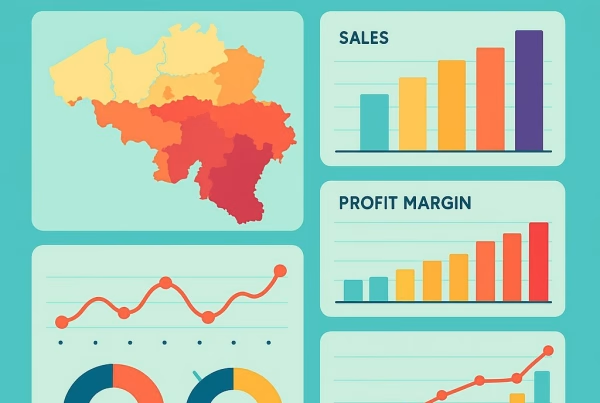If you’re running an aannemer in Antwerp or an architecture firm in Brussels, you’ve probably noticed something troubling: your competitors are showing up on Google while your beautiful portfolio sits gathering digital dust. I’ve seen this pattern dozens of times over my fifteen years consulting Belgian businesses, and honestly? It’s heartbreaking because the solution isn’t as complicated as most people think.
The Belgian construction market is facing a peculiar challenge right now. While the industry is projected to reach €32.3 billion in 2025, growth has slowed to just 0.5% due to inflation and rising bankruptcies. At the same time, 46% of all Google searches are looking for local businesses. That gap between opportunity and visibility? That’s where smart SEO comes in, and it’s especially critical for aannemers, bouwbedrijven, architecten, and interieurontwerpers who need to stand out in Belgium’s uniquely complex market.
Understanding Belgian SEO Complexity

Let me tell you about a client I worked with in 2023—a renovation company based in Ghent. They had an absolutely stunning website showcasing their work, but it was only in Dutch. They were invisible to French-speaking prospects in Brussels and completely missing the German-speaking community in the east. Within six months of implementing a proper multilingual strategy, their qualified leads increased by 170%. This isn’t unusual; it’s actually the norm when you properly address Belgium’s linguistic reality.
Belgium presents a unique SEO challenge that doesn’t exist in neighboring markets. You’re not just optimizing for one language or one search behavior—you’re navigating three official languages (Dutch, French, and German) across distinct regional markets. Flemish users in Antwerp search differently than Walloon prospects in Liège, and both behave differently from the growing expat community searching in English.
The technical implications go deeper than most realize. When you create French content for Belgium, you’re competing with content from France. Dutch content overlaps with the Netherlands. This means your SEO strategy must be hyperlocal and culturally specific, not just translated. A simple keyword like “aannemer” in Flanders becomes “entrepreneur” in Wallonia—and the search intent behind each term varies significantly based on regional construction practices and expectations.
Multilingual Keyword Strategy
Here’s where most Belgian construction businesses make their first critical mistake: they create one website and translate it. That’s not SEO; that’s just translation. Real multilingual optimization means understanding that a homeowner in Knokke searching for “luxe badkamerrenovatie” has different expectations, budget considerations, and design preferences than someone in Liège searching for “rénovation salle de bain haut de gamme.”
Your keyword research needs to address three distinct linguistic markets:
- Flemish Region (Dutch): Focus on terms like “aannemer,” “bouwbedrijf,” “verbouwing,” “renovatie,” and “architect.” These users often include specific location modifiers like “Antwerpen,” “Gent,” or “Brugge.”
- Walloon Region (French): Prioritize “entrepreneur,” “entreprise de construction,” “rénovation,” “architecte,” and “aménagement intérieur.” Brussels-specific searches often include “Bruxelles” or neighborhood names like “Ixelles” or “Uccle.”
- German-Speaking Community: While smaller, don’t ignore terms like “Bauunternehmer,” “Renovierung,” and “Architekt” for the Eupen-Malmedy region.
But here’s the sophisticated part that most agencies miss: search intent varies by language, not just vocabulary. In my experience working with an interior design firm in Brussels, we discovered that Dutch-language searches tended to focus on practical concerns and cost (“prijs,” “kosten”), while French searches emphasized aesthetics and style (“luxe,” “design contemporain”). Your content strategy must reflect these cultural nuances, not just swap out words.
Local SEO Dominance
I remember consulting with a contractor in Mechelen who was frustrated that he wasn’t getting calls despite ranking well for “aannemer België.” The problem? He was optimizing for the country when his service area was 30 kilometers. That’s like shouting into the ocean when you need to whisper directly into someone’s ear. 1Directory.org
Local SEO for Belgian construction professionals requires hyperlocal precision:
- Google Business Profile optimization: Create separate profiles for each language if you serve multiple regions. A profile in Dutch for Antwerp, another in French for Brussels. Ensure your business categories accurately reflect Belgian construction terminology.
- Location-specific content: Don’t create generic “services in Belgium” pages. Build dedicated pages for “Badkamerrenovatie Antwerpen,” “Rénovation cuisine Bruxelles,” and “Dakwerken Gent.” Include neighborhood-specific information, local building codes, and regional architectural styles.
- Local citations and directories: Get listed in Belgian-specific directories like Editus.be, Goudengids.be (for Flanders), and Pages d’Or (for Wallonia). These carry more local authority than international directories.
- Regional building regulations: Mention specific Brussels Capital Region EPB requirements or Flemish VEKA standards. This demonstrates local expertise and captures long-tail searches from informed prospects researching compliance requirements.
The construction sector in particular benefits from geographic specificity because prospects rarely hire contractors from far away. Every page you create should answer the implicit question: “Can this company actually serve my specific neighborhood in my language with understanding of my region’s requirements?”
Technical SEO Foundations
Let’s get into the nuts and bolts that actually determine whether Google shows your site to Belgian prospects. I’ve audited hundreds of construction websites, and the same technical issues appear repeatedly—issues that cost you tens of thousands in lost revenue.
Your technical foundation must address Belgium’s multilingual complexity through proper hreflang implementation. This is non-negotiable. If you’re serving content in multiple languages, you need hreflang tags telling Google which language version to show to which users. For Belgian sites, this typically means:
<link rel="alternate" hreflang="nl-BE" href="https://example.be/nl/badkamerrenovatie" /><link rel="alternate" hreflang="fr-BE" href="https://example.be/fr/renovation-salle-de-bain" /><link rel="alternate" hreflang="de-BE" href="https://example.be/de/badezimmerrenovierung" />
The URL structure matters enormously. I strongly advocate for subdirectories (/nl/, /fr/, /de/) rather than separate domains for most Belgian construction businesses. It consolidates your domain authority and makes management simpler. Country-code top-level domains (.be) signal Belgian relevance to Google, which matters when you’re competing with content from France or the Netherlands.
Site speed is particularly critical for construction sites because you’re typically showcasing high-resolution project photos. But those beautiful 5MB images are killing your rankings. Implement WebP format, lazy loading, and proper image compression. Your portfolio shouldn’t take 8 seconds to load on a Brussels commuter’s mobile phone.
Mobile optimization isn’t optional—it’s primary. More than 60% of initial construction research happens on mobile devices, often while people are standing in their outdated kitchen dreaming of renovations. Your contact forms must work flawlessly on smartphones, your phone numbers should be click-to-call, and your project galleries must swipe smoothly.
Content Marketing Excellence
Here’s a truth I learned working with a sustainable architecture firm in Leuven: nobody Googles “hire an architect.” They search for “how much does a home extension cost in Belgium,” “modern kitchen design ideas,” or “energy-efficient renovation subsidies Flanders.” Your content needs to answer these actual questions, not serve as a brochure.
Create content that demonstrates expertise while capturing search volume:
- Cost guides: “Wat kost een dakisolatie in Vlaanderen 2025?” or “Prix rénovation complète maison Bruxelles”—these capture high-intent searches from qualified prospects
- Process explanations: “Bouwvergunning aanvragen Antwerpen” or “Comment obtenir un permis de construire en Wallonie”
- Design inspiration: “Moderne badkamer trends België 2025” or “Aménagement cuisine ouverte Bruxelles”
- Sustainability content: “Premies energierenovatie Vlaanderen” or “Subventions rénovation énergétique Région wallonne”
The key is addressing region-specific concerns. Flemish prospects need information about VEKA regulations and Vlaamse renovatiepremies. Walloon clients want to know about Région wallonne subsidies and specific building codes. Don’t create generic Belgian content—create hyperspecific regional content that demonstrates you understand their exact situation.
I worked with an interior designer in Hasselt who started publishing monthly posts about color psychology, space optimization for typical Belgian row houses, and incorporating Flemish design heritage into modern interiors. Within eleven months, organic traffic increased 290%, and more importantly, the quality of inbound inquiries improved dramatically because prospects had already been educated through the content.
GDPR Compliance Essentials
This might seem tangential to SEO, but trust me—it’s directly connected to your digital success. Belgium’s Data Protection Authority updated their direct marketing guidance in March 2025, and they’re not playing around. The maximum fine for GDPR violations is 4% of annual turnover or €20 million, whichever is greater.
For construction and architecture websites, GDPR compliance means:
- Transparent cookie consent: Implement a compliant cookie banner that clearly explains what data you collect and why. The Belgian DPA prioritizes direct marketing scrutiny, so vague consent won’t cut it
- Contact form compliance: Clearly state how you’ll use submitted information. If someone requests a renovation quote, you can’t automatically add them to a newsletter without separate explicit consent
- Data minimization: Only collect information you actually need. You don’t need someone’s birthdate to provide a bathroom renovation estimate
- Privacy policy specificity: Generic templates aren’t enough. Your privacy policy must specifically address Belgian regulations and be available in all languages your site serves
Beyond legal compliance, there’s an SEO angle here. Google increasingly factors user trust signals into rankings, and a site that handles data responsibly, loads quickly, and provides clear privacy information sends positive signals. Belgian users are particularly privacy-conscious, so prominent, clear GDPR compliance can actually improve conversion rates.
Link Building Strategy
I’ll be honest: link building in Belgium is harder than in larger markets, but that’s actually good news for you. Your competitors probably aren’t doing it well either, which means moderate effort produces outsized results.
Focus on Belgian-specific link opportunities:
- Industry associations: Join Confederatie Bouw (Dutch-speaking region), Confédération Construction (French-speaking region), or regional architecture associations and ensure your membership includes a website link
- Supplier relationships: If you use Wienerberger bricks or Saint-Gobain materials, request inclusion in their architect/contractor directories
- Local journalism: Pitch renovation trend stories to regional newspapers like De Standaard, Le Soir, or Het Nieuwsblad. Including expert commentary from local contractors/architects often results in attributed links
- Project showcases: Encourage clients to mention your work on their company websites if you’ve renovated commercial spaces
- Sustainable construction: Belgium is pushing heavily toward energy efficiency. Content about sustainable renovation techniques attracts links from environmental organizations, municipal sustainability initiatives, and energy certification bodies
The most effective link I’ve seen a client acquire came from a detailed guide about Brussels’ strict facade renovation regulations. An architecture school professor linked to it as a resource, which Google loved because it was genuinely useful, locally specific, and authoritative.
Measuring Real Results
Here’s where most Belgian construction businesses go wrong: they track vanity metrics instead of business outcomes. You don’t need more traffic; you need more qualified project inquiries from prospects who can afford your services and are located within your service area.
Set up conversion tracking for:
- Quote request form submissions: Assign value based on your average project size and closing rate
- Phone calls: Implement call tracking to understand which keywords and content drive phone inquiries
- Architectural consultation bookings: If you’re an architect or interior designer, track when visitors schedule initial consultations
- Location-specific conversions: Separate Brussels inquiries from Antwerp leads to understand which regional strategies work best
Use Google Search Console to monitor rankings for your priority keywords in each language. Watch for position improvements on terms like “aannemer [city],” “architecte [region],” or “rénovation [neighborhood].” These hyperlocal terms might have lower volume but dramatically higher conversion rates.
I recommend reviewing your organic performance quarterly, not monthly. SEO is a medium-term investment, and month-to-month fluctuations will drive you crazy without providing actionable insights. Instead, look at quarterly trends: Are your Dutch-language pages gaining traffic? Are French-language conversions improving? Is your Ghent content outperforming your Liège content?
Competitive Intelligence
Your competitors are either ignoring SEO entirely (good for you) or implementing it poorly (also good for you). The Belgian construction sector lags behind other industries in digital sophistication, which creates enormous opportunity for businesses willing to invest properly.
Conduct quarterly competitive analysis:
- Search your primary service keywords in each language and region
- Analyze which competitors rank well and study their on-page optimization
- Review their backlink profiles using tools like Ahrefs or SEMrush
- Identify content gaps—topics they haven’t covered that your prospects search for
- Monitor their multilingual implementation (most do it wrong)
I recently analyzed the top 20 contractors ranking in Antwerp. Only three had proper hreflang implementation. Only one had dedicated pages for neighborhood-specific services. And none had comprehensive content addressing the full renovation process in Dutch. That’s your opportunity.
The architecture sector is slightly more sophisticated, but even there, I see firms with stunning portfolios and zero content marketing, no blog, and generic service pages that could apply to any architect anywhere. If you’re willing to publish one quality article monthly addressing actual prospect questions, you’ll outrank 80% of your competition within a year.
Future-Proofing Your Strategy
SEO in 2025 isn’t the same as it was in 2020, and it’ll be different again in 2027. Google’s AI Overviews are changing how search results appear, pushing traditional organic listings down the page. Voice search continues growing. And Belgium’s digital landscape keeps evolving.
Stay ahead by focusing on:
- E-E-A-T signals: Google wants to see Experience, Expertise, Authoritativeness, and Trustworthiness. Showcase your projects, certifications, years in business, and industry affiliations prominently
- Video content: Create walkthroughs of completed projects, renovation process explanations, and design consultations. Video increasingly appears in Google results and works across language barriers
- Structured data: Implement LocalBusiness schema, Review schema, and FAQPage schema to help Google understand your content and potentially earn rich snippets
- User experience: Google’s algorithm increasingly rewards sites that provide excellent user experiences—fast loading, mobile-friendly, easy navigation, and clear conversion paths
The construction businesses that will dominate Belgian search results in coming years aren’t necessarily the biggest or oldest—they’re the ones that consistently publish helpful, locally relevant content in multiple languages while maintaining technical excellence and building genuine authority through quality backlinks.
After fifteen years working with Belgian businesses across sectors, I can tell you this with certainty: the contractors and architects who invest in proper SEO today will capture the lion’s share of organic leads tomorrow. While your competitors keep throwing money at Facebook ads that stop working the moment you pause spending, your SEO investment compounds, building authority and visibility that continues attracting qualified prospects month after month, year after year.
The Belgian market’s linguistic complexity isn’t a barrier—it’s a moat protecting those smart enough to navigate it properly. Start with solid technical foundations, create genuinely helpful content in each language, optimize for hyperlocal searches, and measure what matters. Do that consistently for twelve months, and you’ll wonder why you didn’t start sooner.







